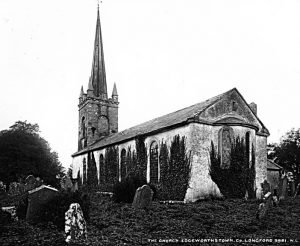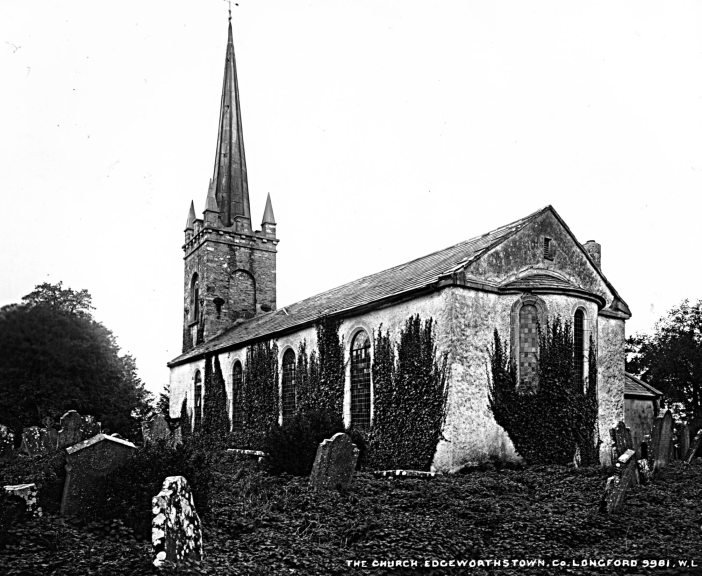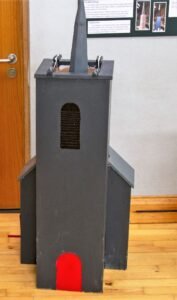




In 1811 – Richard Lovell Edgeworth, with the aid of his son William, erected the spire onto the Church of St. John’s in Edgeworthstown.
St John’s Church
To begin with several buildings occupied this site but it is not known when the present church was built. The site of the parish church was the same when the Down Survey was made in the 17th century. Therefore it was just known as the church of the Edgeworth family.
The spire lasted until 1935 when it was dislodged during a storm and was removed for safety reasons.
As part of a project for the Maria Edgeworth Festival in 2023 and an Education Conference a replica was made. To celebrate the Edgeworth’s legacy some of the 6th class students from St. John’s National School, Edgeworthstown made a model of the spire in conjunction with the Maria Edgeworth Centre.
At the present time you can see a replication now on display in the Maria Edgeworth Centre.
It was in 1811 that Edgeworth constructed, ‘upon a plan of his own invention’, a spire for the church of
Edgeworthstown. This spire was formed of a skeleton of iron, covered with slates, painted and sanded to
resemble Portland stone. It was put together on the ground within the tower of the church, and when finished it was drawn up at once, with the assistance of counterbalancing weights, to the top of the tower, and there to be fixed in its place.
Below is an account from his memoirs:
The erection of the spire was a major event in the lives of the community.
‘The novelty of the construction of this spire, even in this its first skeleton state, excited attention, and as it
drew towards its completion, and near the moment when, with its covering of slates, altogether amounting to
many tons weight, it was to move, or not to move, fifty feet from the ground to the top of the tower,
everybody in the neighbourhood, forming different opinions of the probability of its success or failure,
became interested in the event.
‘Several of my father’s friends and acquaintances, in our own and from adjoining counties, came to see it
drawn up. Fortunately, it happened to be a very fine autumn day, and the groups of spectators of different
ranks and ages, assembled and waging in silent expectation, gave a picturesque effect to the whole. A bugle
sounded as the signal for ascent. The top of the spire appearing through the tower of the church, began to
move upwards; its gilt ball and arrow glittered in the sun, while with motion that was scarcely perceptible it
rose majestically. Not one word or interjection was uttered by any of the men who worked the windlasses at
the top of the tower.
‘It reached its destined station in eighteen minutes, and then a flag streamed from its summit and gave notice
that all was safe. Not the slightest accident or difficulty occurred.’ Maria adds:–‘The conduct of the whole had
been trusted to my brother William (the civil engineer), and the first words my father said, when he was
congratulated upon the success of the work, were that his son’s steadiness in conducting business and
commanding men gave him infinitely more satisfaction than he could feel from the success of any invention
of his own.’
The best way to keep in touch and to be aware of our events
Don’t forget to confirm your subscription in the Email we just sent you!
Please pre-book your visit over Christmas and New Year at least 24h in advance via Email or Online booking.
MondayClosed
Tuesday10:00 AM - 5:00 PM
Wednesday10:00 AM - 5:00 PM
Thursday10:00 AM - 5:00 PM
Friday10:00 AM - 5:00 PM
Saturday11:00 AM - 5:00 PM
Sunday11:00 AM - 5:00 PM
Adult €7.50
Children 10 to 16 €3
2 Adults & 2 Children €15
Adult is 16 years+
Family Ticket is 4 family members together
Children under ten are free but must be accompanied by an Adult

This project was assisted by Longford Local Community Development Committee, Longford Community Resources Clg. and Longford County Council through the LEADER Programme 2023 -2027 which is part-financed by the EU, “The European Agricultural Fund for Rural Development: Europe investing in rural areas” and the Department of Rural & Community Development
The Maria Edgeworth Centre is operated under the direction of the Edgeworthstown District Development Association (EDDA) – a Not for Profit Voluntary Community based registered charity Reg:223373. Registered Charity Number 20101916
© 2023 Maria Edgeworth Centre – All Rights Reserved